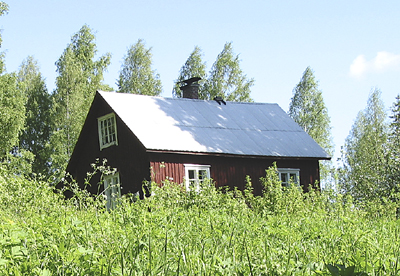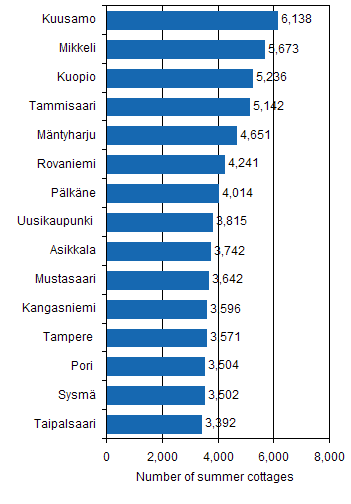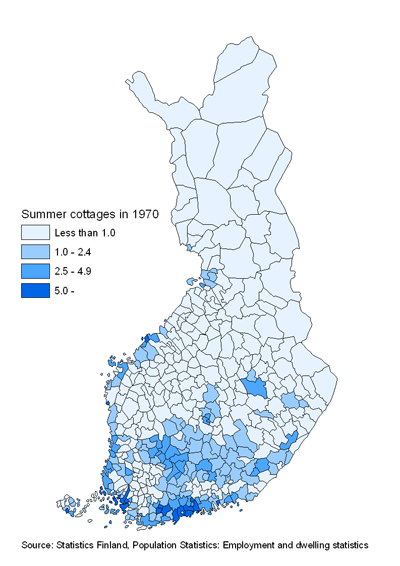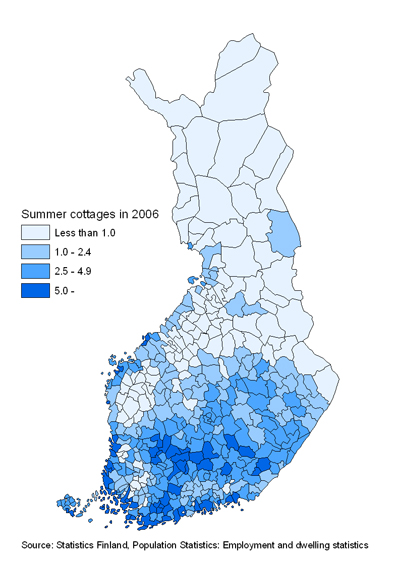From villa ownership to national leisure-time activity
The construction of summer villas started in Finland already in the 19th century, but during the early years of Finnish independence, villa life was attainable only for a select few. In those days there were roughly 3,000 villas in Finland. Spending time at the summer cottage became a pastime for the entire population only in the 1950s. At the end of 2006 there were nearly half a million summer cottages in Finland.

The construction of summer cottages started in Finland in the early 19th century, when villa communities built by the wealthy bourgeoisie began to grow in the periphery of the major cities. In those days villas were mostly large and decorative buildings intended for use during leisure-time and in summer. In the early days only urban families acquired villas for their own use. Initially the villa phenomenon was actually a product of urban culture.
In the early 20th century there were a good 1,000 villas in Finland and at the time of gaining independence their number had grown to roughly 3,000. The first allotment gardens were also established at the time of gaining independence; in 1919 in Tampere and in 1918 in both Helsinki an Oulu. From the 1930s onwards, allotment gardens were established in many other cities as well.
In the newly independent Finland only the wealthy had villas
The Interwar period was a time of economic growth and development in Finland. The size of the urban population doubled during the period. The number of available or not yet built waterside sites near major cities started to decrease and the search for a location for the summer residence had to be extended farther than before. Distance did not, however, prevent the acquisition of villas, thanks to quickly improving transport conditions. Bus and private car transport started to become more common as from the 1920s, and railroad and boat transport as the villa owners' mode of transport were gradually abandoned nearly completely.
During the two decades following the gaining of independence the number of villas in Finland quadrupled. The affluent population of rural population centres and industrial centres began to follow the urban populations' example and acquired villas. In 1940 Finland had over 20,000 villas. A striving for simplicity and practicality can be seen in villas constructed after the gaining of independence. Luxurious decorating decreased and villas started to emulate the detached houses of suburban regions. Small weekend cottages also started to appear in greater numbers than earlier. Gardening was a fundamental element of villa life, and the products of the garden were an important part of a family's diet.
Villa ownership became popularised after the wars
The acquiring of summer villas got gradually more common after the war years. In the 1930s, on average 900 new villas were acquired each year, but in the 1950s the number of acquired new villas was already fivefold, or 4,800.
Spending time at the summer cottage became a national pastime in the 1950s. During that decade the Finnish villa stock grew by more than during the entire previous century. Urbanisation speeded up the growth in the number of summer cottages, as large numbers of people born in rural areas transferred to cities to work in industry or the service branches. At the same time people slowly got more leisure-time. When Saturday became a day off work in the 1960s, more time could be spent at the summer cottage also during the weekends.
In his doctoral thesis (1966) Olli Vuori examined the number of summer villas in the 1960s and before. In 1950 there were roughly 40,000 villas, and in 1960 they already numbered 88,000. The number of villas exceeded the 100,000 limit in 1962, which meant that every 13th household owned a summer cottage.
The longing for rural life was one reason for the proliferation of summer cottages. In 1960 one half of the city and market town population was made up of first generation urban dwellers, that is, people born in rural municipalities. In those days villa owners were still concentrated to a few major cities. In 1962 roughly 42 per cent of Finland's villa owners were living in the three largest cities and over 55 per cent were living in the ten largest cities. On the other hand, villa ownership was quickly becoming more common also among the population of rural municipalities. In 1940 people living in rural municipalities owned only roughly five per cent of the villas in the country, but in 1962 they already owned nearly one fifth of them.
Villa ownership became popularised at the end of the 1950s, when modest summer cottages and weekend cottages gradually started to become more common. When extensive demands were no longer made on the size and standard of equipment of the villas, more and more people were able to acquire a summer cottage. It was possible to enjoy the outdoors and nature also with a more modest summer cottage.
An opposite trend started to become visible in the 1960s: people started to expect villas to be roomy and equipped as well as urban dwellings. Summer cottages started to be used more and more commonly as the family's secondary residence through the year, and not just in summer. The summer dwelling was slowly transformed from a residence to be used only in summer into a general leisure-time residence.
The 1980s the peak years in cottage construction
The first comprehensive free-time residence statistics were collected in the 1970 population census. At that time the number of cottages was already 176,000. The ownership of a summer cottage had become typical for all population groups. In 1970 nearly one fourth of the heads of household-dwelling units that owned a summer cottage were classified as employees according to their socio-economic status, whereas 30 per cent of all heads of household-dwelling units were employees.
In the 1980 population census there were 251,700 summer cottages, i.e. the number had grown by 43 per cent in a decade. The number of summer cottages continued to grow and the growth was strongest in the 1980s: over 100,000 new cottages were built during a ten year period. The number of cottages grew because of construction of new cottages and the use of existing dwellings as summer cottages.
In 1990 there were 368,000 cottages, which is 46 per cent more than in 1980. Cottage construction has slowed down since then; in the 1990s the number of cottages grew by only 23 per cent. In the early 1990s, roughly 8,000 cottages were built every year but in recent years the pace has slowed down to one half of that. During the years of Finnish independence, the Finnish summer cottage stock has grown to nearly half a million. At the end of 2006, the total number of summer cottages in Finland was 475,000.
Varsinais-Suomi has the most summer cottages
At the end of 2006, the number of summer cottages was the highest, at roughly 47,000, in Varsinais-Suomi. Pirkanmaa and Etelä-Savo also had more than 40,000 summer cottages. Among the municipalities, Kuusamo had the highest number, over 6,000, of summer cottages. Mikkeli, Kuopio and Tammisaari also reached high numbers (see figure below). All in all 29 municipalities had over 3,000 summer cottages.
On the other hand, there are also municipalities with very few summer cottages and municipalities where the number of cottages has gone down, e.g. the major cities. In 1970 Helsinki still had over 2,000 summer cottages and Espoo nearly 4,000, but by the end of 2006 Helsinki had only 391 buildings classified as summer cottages and the corresponding number in Espoo was 1,653.
Municipalities with the highest numbers of summer cottages on 31 December 2006

At the end of 2006 the highest number of new leisure-time residences built in 1990 or later, were located in Lapland, where new cottages numbered nearly 10,000. This number is one third of the summer cottage stock in Lapland. The proportion of new summer cottages was the lowest in Itä-Uusimaa and Uusimaa, where only below one sixth of the summer cottage stock has been built in 1990 or later. During the most recent years summer cottage construction has been the most active in Lapland, Etelä-Savo and Varsinais-Suomi, each of which have had roughly 400 new summer cottages every year.
Summer cottages are concentrated in the areas surrounding major cities and areas near bodies of water. Currently the whole country has, on average, 1.6 summer cottages per square kilometre of land. Of the regions, summer cottage density is the highest in Uusimaa, where they number 4.7 per square kilometre. Varsinais-Suomi and Päijät-Häme also have more than 4 summer cottages per square kilometre, on average. The regions of Lapland, Kainuu and Central, Northern and Southern Ostrobothnia, then again, have less than one summer cottage per square kilometre.
Summer cottage density has grown by the most since the 1970s in Varsinais-Suomi and Åland, by more than 2.5 summer cottages per each square kilometre of land. Summer cottage density has grown, on average, by more than two cottages per square kilometre of land also in the regions of Kanta-Häme, Päijät-Häme, South Karelia, Etelä-Savo and Pirkanmaa.
Twelve municipalities had more than 10 summer cottages per square kilometre at the end of 2006. Summer cottage density was the highest in Kaskinen, Merimasku, Kustavi, Sammatti and Velkua, each of which had, on average, 16-18 summer cottages per square kilometre of land.
Summer cottages per square kilometre by municipality in 1970 and 2006


Summer residents important for municipalities' business
The population of many municipalities doubles during the summer months. Summer residents are important to the shopkeepers and service provides of many municipalities. In 2005 the highest numbers of summer residents from outside the municipality came to Mäntyharju, Tammisaari, Puumala, Asikkala and Ruokolahti, each of which received over 5,000 summer residents. Relatively speaking the highest growth in population in the summer was in Kustavi, where the number of summer residents was four times that of the municipality's permanent population.
The summer cottage is often located near the owner's permanent residence. In 2006 roughly one third of the cottage owners had a cottage in their municipality of residence and roughly 60 per cent in the region of residence. The most loyal cottagers in their municipality of residence are the people living in Iniö, Houtskari, Kökar, Kuhmo, Ranua and Kustavi. Of cottage owners in Uusimaa less than 30 per cent owned a summer residence within their region of residence. According to the summer cottage survey 2003, distance to the summer cottage was, on average, 107 kilometres. One half of the cottagers journeyed less that 50 kilometres to their summer cottage.
Summer cottages have grown in size
At the end of 2006 the average floor space of a summer cottage was 47 square metres. The average floor space of summer cottages has grown by approximately seven square metres since 1970. At the end of 2006 the largest cottages were found in Itä-Uusimaa, where the average floor space was 53 square metres. The smallest summer cottages were in South Karelia, where the average floor space was 43 square metres. The number of cottages with more than 100 square metres of floor space was 23,000, whereas the number of small cottages with less than 20 square metres of floor space was 37,000. The average floor space of the newest cottages, i.e. those built in the 2000s, was 61 square metres, and only four per cent of the new cottages had less than 20 square metres of floor space.
In 2006 the average age of the owners of newly built cottages was 53 years, while the average age of all cottage owners was 60 years. Less than 25,000, that is, only 6 per cent of all cottage owners were younger than 40 years of age. One fifth of the household dwelling units which own a cottage had children younger than 18 years of age.
The standard of equipment has risen
These days living at the summer cottage does not necessarily have to be primitive and without comforts and amusements. According to the summer cottage survey 2003, 70 per cent of cottages are connected to the electricity network. In addition, electricity was produced at summer cottages with solar power panels and generators, which means that a total of over 80 per cent of cottages had a source of electricity.
Access to clean drinking and fresh water was not secured quite as well. One half of cottage owners brought the drinking and fresh water to be used at the cottage from elsewhere in containers and nearly one half used their own well or a neighbour's well. Waste water from the main building and the sauna were mainly filtered into the ground either directly or via a sedimentation basin. Only one per cent of the water used in the sauna was led directly into bodies of water. The majority of cottages, i.e. 70 per cent, had a traditional latrine. The rest had an indoor toilet or a composting toilet indoors or outside.
According to the summer cottage survey 2003, 16 per cent of summer cottages were so-called dry land cottages without a direct access to the shore. One half of the cottages were suitable for use in the spring, summer and autumn, but not all year round. Roughly 29 per cent of the cottages could also be used in winter, and one fifth could be used only in the summer.
Tables:
Summer cottages by region
1970-2006 (Excel file)
Municipalities with the
biggest decrease in the number of summer cottages 1970-2006
(Excel file)
Municipalities with the
biggest increase in the number of summer cottages 1980-2006
(Excel file)
Inquiries: Ms Arja Tiihonen +358 9 1734 3272
Sources and links:
- Home page of the free-time residence statistics
- Free-time residence statistics 2006, Statistics Finland
- Nieminen, Markku (2004). Summer cottage survey 2003, key results from the mail survey data Statistics Finland, Ministry of the Interior. (In Finnish only.)
- Building and dwelling production, Statistics Finland
- Vuori Olli (1996). Villa ownership in Finland. A study of summer residences and villa ownership as an economic phenomenon. University of Turku, Publication series C part 3. (In Finnish only.)
Last updated 18.6.2007
